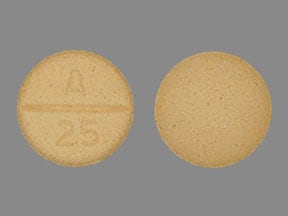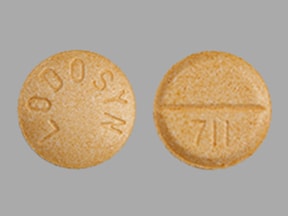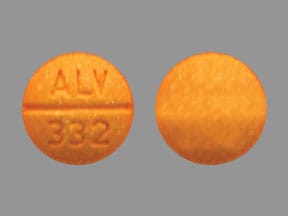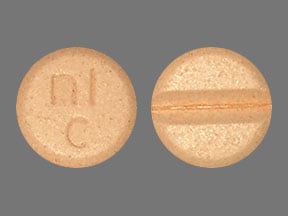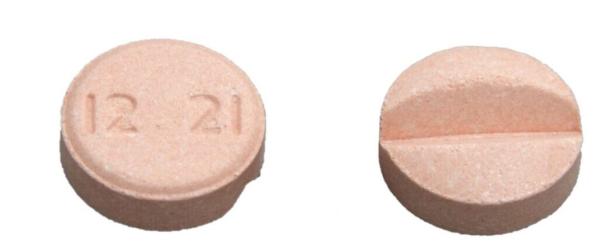Dosage Forms
Excipient information presented when available (limited, particularly for generics); consult specific product labeling.
Tablet, Oral:
Lodosyn: 25 mg [scored; contains fd&c yellow #6 (sunset yellow)]
Generic: 25 mg
Pharmacology
Mechanism of Action
Carbidopa is a peripheral decarboxylase inhibitor with little or no pharmacological activity when given alone in usual doses. It inhibits the peripheral decarboxylation of levodopa to dopamine; and as it does not cross the blood-brain barrier, unlike levodopa, effective brain concentrations of dopamine are produced with lower doses of levodopa. At the same time, reduced peripheral formation of dopamine reduces peripheral side-effects, notably nausea and vomiting, and cardiac arrhythmias, although the dyskinesias and adverse mental effects associated with levodopa therapy tend to develop earlier.
Pharmacokinetics/Pharmacodynamics
Distribution
Does not cross the blood-brain barrier
Use: Labeled Indications
Parkinsonism: Given with carbidopa/levodopa in the treatment of idiopathic Parkinson disease, postencephalitic parkinsonism, and symptomatic parkinsonism, which may follow injury to the nervous system by carbon monoxide and/or manganese intoxication.
Note: Administration of carbidopa allows use of a lower dosage of levodopa, more rapid titration, and a decrease in nausea and vomiting associated with levodopa; use with carbidopa/levodopa in patients requiring additional carbidopa; has no effect without levodopa.
Contraindications
Hypersensitivity to carbidopa or any component of the formulation; use of nonselective MAO inhibitor therapy with or within prior 14 days (however, may be administered concomitantly with the manufacturer's recommended dose of an MAO inhibitor with selectivity for MAO type B); narrow-angle glaucoma
Dosage and Administration
Dosing: Adult
Parkinsonism: Oral: Note: Optimal daily dosage determined by careful titration; generally if carbidopa is ≥70 mg/day, a 1:10 proportion of carbidopa:levodopa provides the most patient response.
Carbidopa augmentation in patients receiving carbidopa-levodopa:
Patients receiving carbidopa/levodopa 10/100: 25 mg daily with first daily dose of carbidopa/levodopa; if necessary, 12.5 to 25 mg may be given with each subsequent dose of carbidopa/levodopa; maximum: 200 mg/day (including from carbidopa/levodopa)
Patients receiving carbidopa/levodopa 25/250 or carbidopa/levodopa 25/100: 25 mg with any dose of carbidopa/levodopa throughout the day; maximum: 200 mg/day (including from carbidopa/levodopa)
Dosing: Geriatric
Refer to adult dosing.
Administration
Administer with meals to decrease GI upset.
Dietary Considerations
May be taken with meals to decrease GI upset.
Storage
Store at room temperature of 25°C (77°F); excursions permitted to 15°C to 30°C (59°F to 86°F).
Carbidopa Images
Drug Interactions
Droxidopa: Carbidopa may diminish the therapeutic effect of Droxidopa. Carbidopa may decrease serum concentrations of the active metabolite(s) of Droxidopa. Carbidopa may increase the serum concentration of Droxidopa. Monitor therapy
Spiramycin: May decrease the serum concentration of Carbidopa. And thus may decrease the effectiveness of levodopa. Monitor therapy
Test Interactions
False-positive reaction for urinary glucose with Clinitest®; false-negative reaction using Clinistix®; false-positive urine ketones with Acetest®, Ketostix®, Labstix®
Adverse Reactions
Adverse reactions are associated with concomitant administration with levodopa.
Cardiovascular: Cardiac arrhythmia, chest pain, edema, flushing, hypertension, hypotension, myocardial infarction, orthostatic hypotension, palpitation, phlebitis, syncope
Central nervous system: Abnormal dreams, abnormal gait, agitation, anxiety, ataxia, confusion, decreased mental acuity, delusions, dementia, depression (with or without suicidal tendencies), disorientation, dizziness, drowsiness, euphoria, extrapyramidal reaction, falling, fatigue, glossopyrosis, hallucination, headache, Horner's syndrome, impulse control disorder, insomnia, malaise, memory impairment, nervousness, neuroleptic malignant syndrome, nightmares, numbness, on-off phenomenon, paranoia, paresthesia, pathological gambling, peripheral neuropathy, psychosis, seizure (causal relationship not established), trismus
Dermatologic: Alopecia, bulla, diaphoresis, discoloration of sweat, skin rash
Endocrine & metabolic: Abnormal lactate dehydrogenase, glycosuria, hot flash, hyperglycemia, hypokalemia, increased libido (including hypersexuality), increased uric acid, weight changes
Gastrointestinal: Abdominal distress, abdominal pain, anorexia, bruxism, constipation, diarrhea, discoloration of saliva, duodenal ulcer, dysgeusia, dyspepsia, dysphagia, flatulence, gastrointestinal hemorrhage, heartburn, hiccups, nausea, sialorrhea, sore throat, vomiting, xerostomia
Genitourinary: Priapism, proteinuria, urinary frequency, urinary incontinence, urinary retention, urinary tract infection, urine discoloration
Hematologic & oncologic: Abnormal Coombs' test, agranulocytosis, anemia, decreased hematocrit, decreased hemoglobin, hemolytic anemia, leukopenia, malignant melanoma, thrombocytopenia
Hepatic: Abnormal alanine aminotransferase, abnormal alkaline phosphatase, abnormal aspartate transaminase, abnormal bilirubin levels, abnormal lactate dehydrogenase
Hypersensitivity: Angioedema, hypersensitivity reaction (bulla, IgA vasculitis, pruritus, urticaria)
Neuromuscular & skeletal: Back pain, dyskinesia (including choreiform, dystonic, and other involuntary movements), leg pain, muscle cramps, muscle twitching, shoulder pain, tremor, weakness
Ophthalmic: Blepharospasm, blurred vision, diplopia, mydriasis, oculogyric crisis (may be associated with acute dystonic reactions)
Renal: Increased blood urea nitrogen, increased serum creatinine
Respiratory: Cough, dyspnea, hoarseness, upper respiratory tract infection
Warnings/Precautions
Concerns related to adverse effects:
- Depression: Observe patients closely for development of depression with concomitant suicidal tendencies.
- Dyskinesias: May cause or exacerbate dyskinesias.
- Impulse control disorders: Antiparkinson therapy has been associated with compulsive behaviors and/or loss of impulse control, which has manifested as pathological gambling, libido increases (hypersexuality), urges to spend money uncontrollably, and/or binge eating. Dose reduction or discontinuation of therapy has been reported to reverse these behaviors in some, but not all cases.
- Melanoma: Risk for melanoma development is increased in Parkinson disease patients; drug causation or factors contributing to risk have not been established. Patients should be monitored closely and periodic skin examinations should be performed.
- Psychotic effects: May cause hallucinations and psychotic-like behavior.
- Somnolence: Patients have reported falling asleep while engaging in activities of daily living; this has been reported to occur without significant warning signs. Monitor for daytime somnolence or preexisting sleep disorder; caution with concomitant sedating medication; consider discontinuing if significant daytime sleepiness or episodes of falling asleep occur. Patients must be cautioned about performing tasks which require mental alertness (eg, operating machinery, driving).
Disease-related concerns:
- Psychotic disorders: Avoid use in patients with major psychotic disorder.
Concurrent drug therapy issues:
- Drug-drug interactions: Potentially significant interactions may exist, requiring dose or frequency adjustment, additional monitoring, and/or selection of alternative therapy. Consult drug interactions database for more detailed information.
Other warnings/precautions:
- Appropriate use: Carbidopa has no antiparkinsonian activity when administered alone; must administer with carbidopa/levodopa. When administering to carbidopa-naive patients, administer carbidopa and carbidopa/levodopa at the same time; allow at least 12 hours to elapse between the last dose of carbidopa/levodopa and initiation of carbidopa.
- Discontinuation of therapy: Abrupt withdrawal or discontinuation of carbidopa/levodopa been associated with a syndrome resembling neuroleptic malignant syndrome (NMS).
Monitoring Parameters
Signs and symptoms of Parkinson disease; CBC, liver function tests, renal function; blood pressure, mental status; signs and symptoms of neuroleptic malignant syndrome if abrupt discontinuation required (as with surgery); periodic intraocular pressure (in patients with wide-angle glaucoma); periodic skin examinations
Pregnancy
Pregnancy Considerations
Carbidopa can be detected in the umbilical cord but absorption in fetal tissue is minimal (Merchant 1995). The incidence of Parkinson disease in pregnancy is relatively rare and information related to the use of carbidopa in pregnant women is limited to use with other agents. Refer to the carbidopa and levodopa monograph for additional information.
Patient Education
- Discuss specific use of drug and side effects with patient as it relates to treatment. (HCAHPS: During this hospital stay, were you given any medicine that you had not taken before? Before giving you any new medicine, how often did hospital staff tell you what the medicine was for? How often did hospital staff describe possible side effects in a way you could understand?)
- Patient may experience dry mouth, diarrhea, nausea, vomiting, fatigue, trouble sleeping, or nightmares. change in taste, constipation, or lack of appetite. Have patient report immediately to prescriber signs of depression (thoughts of suicide, anxiety, emotional instability, or confusion); behavioral changes; sensing things that seem real but are not; uncontrollable urges; severe headache; confusion; abnormal heartbeat; narcolepsy; vomiting blood; black, tarry, or bloody stools; abdominal pain; burning or numbness feeling; bruising; bleeding; abnormal movements; teeth grinding; shortness of breath; severe loss of strength and energy; swelling of arms or legs; severe dizziness; passing out; chest pain; chills; sore throat; skin growths; mole changes; eye pain; severe eye irritation; vision changes; or signs of neuroleptic malignant syndrome (fever, muscle cramps or stiffness, dizziness, severe headache, confusion, change in thinking, fast heartbeat, abnormal heartbeat, or sweating a lot) (HCAHPS).
- Educate patient about signs of a significant reaction (eg, wheezing; chest tightness; fever; itching; bad cough; blue skin color; seizures; or swelling of face, lips, tongue, or throat). Note: This is not a comprehensive list of all side effects. Patient should consult prescriber for additional questions.
Intended Use and Disclaimer: Should not be printed and given to patients. This information is intended to serve as a concise initial reference for healthcare professionals to use when discussing medications with a patient. You must ultimately rely on your own discretion, experience and judgment in diagnosing, treating and advising patients.
